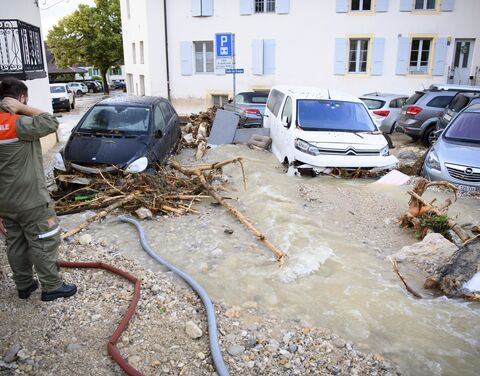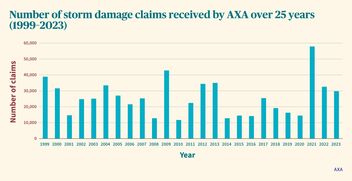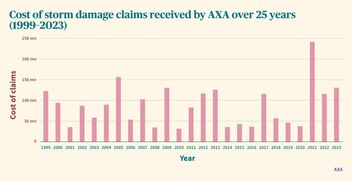
AXA figures show an increase in storm damage claims over the past three years. It is too soon to call this a trend, but storms do seem to hit harder and more suddenly than they used to. At the same time, however, preventive measures taken by the federal, cantonal, and communal governments are having a positive effect on the number of claims.
As Switzerland's largest all-lines insurer, AXA possesses a great deal of data concerning where and when storm damage occurred in recent years and how bad it was. The statistics for the 25-year period to 2023 show that 2021 was a standout year in terms of both the number of claims and the resulting cost. However, 1999, 2000, 2004, 2009, 2012, 2013, 2022, and 2023 also saw very high numbers of claims, whereas the situation was calmer in the years 2014 to 2020 (see first chart below). The picture is similar with regard to the cost of claims (see second chart below), with exceptionally high average claim costs in 2005 and 2017. For 2005, this can be explained by the widespread flooding due to Alpine waterways bursting their banks, while 2017 saw multiple large claims as a result of localized heavy rain.

Including motor vehicle, household contents, corporate property, watercraft, and engineering insurance

Including motor vehicle, household contents, corporate property, watercraft, and engineering insurance
"We've noticed an increase in claims in the past three years, but this is too short a period to call it a trend. Storm damage claims are highly volatile," notes Stefan Müller, Head of Property Claims at AXA. "That said, our experience shows that storms are happening more suddenly than they used to, and their intensity has increased dramatically. We're seeing extreme gusts of wind, more heavy rainfall, and a greater frequency of large hailstones – all of which are sometimes highly localized," he adds. This has given rise to new dangers. For example, heavy rain can transform roads into hazardous rivers in built-up areas and even fill underground parking garages with water. This is only partially reflected in the statistics, since the Confederation, the cantons, and the communes have also been spending more or protective measures. Flood relief tunnels, retention basins, raised dams, and the national flood risk map are all paying off.
Not all regions of Switzerland are exposed to the same risks. AXA's claims statistics paint a clear picture of where the various kinds damage occurred most often. Hail damage to cars makes up the largest share of storm damage claims in terms of both number and cost. The cantons of Jura, Ticino, and Neuchâtel, together with Nidwalden, Obwalden, Lucerne, Schwyz, and Bern, were most affected over the past 20 years. "Major hail events in particular, which can damage a vast quantity of cars within a short time frame, are a key factor with regard to the number of claims," says Patrick Villiger, Head of Motor Vehicle Claims at AXA. Schaffhausen, Geneva, Graubünden, Glarus, and Thurgau, meanwhile, recorded hardly any hail damage.
The highest incidence of flood damage per insured household occurred in the canton of Schwyz over the past ten years, followed by Solothurn, Thurgau, and Lucerne. It must be noted, however, that single flooding events pushed claims numbers up sharply in each case. The cantons of Vaud, Graubünden, Basel-Land, and Uri remained mostly free from flooding over the past ten years.
When it comes to lightning damage, one canton tops the list by a considerable margin: over the past ten years, the risk of damage due to lightning strikes in Ticino has been seven times higher than in the rest of Switzerland. AXA registers several hundred claims on household contents insurance in the canton every year. Compared with the cantons of Basel-Land, Vaud, and Geneva, the risk was in fact 25 times higher. It is not hard to understand why. When warm, humid air from the Mediterranean moves northward and hits the Alps, it forms storm clouds with strong upward and downward winds as well as high levels of electrical charge, which is discharged in the form of lightning.
If you take some precautions, you can minimize the risk of storm damage to your property. Apps are available that quickly send a push message whenever there is a weather warning in your location. If a storm with strong winds is on the way, you should make sure that movable items like grills and garden chairs are firmly secured or taken inside and retract your sunshades. If there is going to be heavy rain, you should also check that your drains are not blocked and close your windows. When there is a risk of water leaking into the building, you should place all valuables and anything susceptible to water damage somewhere high up. In the event of hail, vehicles should be brought under cover and shutters rolled up. According to Stefan Müller, many people do not realize that "hail can't really damage windows, but it can definitely damage shutters."
Storm damage can be covered by different forms of insurance, depending on what it affects. Furniture and fittings are covered on a new-for-old basis under household contents insurance. Partial accidental damage insurance, meanwhile, covers storm damage to vehicles. If the building itself is damaged, this is covered by building insurance, which is provided by a cantonal institution in most regions.